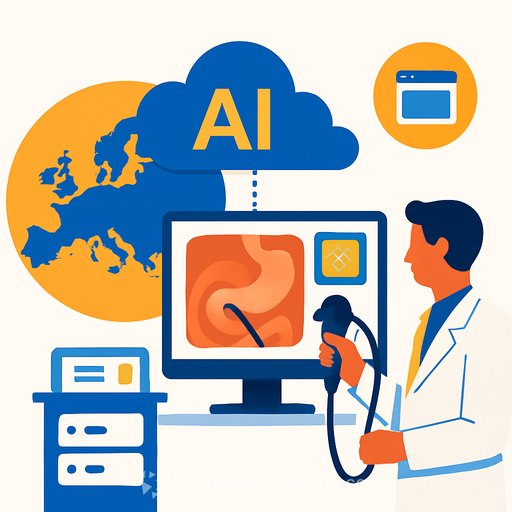Olympus launches OLYSENSE CAD/AI: three cloud apps to support GI teams in early diagnosis and workflow
Olympus Europa SE & Co. KG has commercially launched the first three applications in its OLYSENSE CAD/AI portfolio in selected European countries. The integrated, cloud-based suite connects software and endoscopic devices to support both clinical and operational performance. This marks the first step toward Olympus' intelligent endoscopy ecosystem, with a focus on earlier detection and consistent assessments during procedures.
"Since developing the world's first gastro-camera over 70 years ago, Olympus has been committed to addressing the evolving needs of both healthcare providers and patients in the field of endoscopy," said Miquel-Àngel García, Sr. Vice President and General Manager of Endoscopy Solutions Ecosystem at Olympus. "Launching an intelligent endoscopy ecosystem that connects software, hardware, and services across the whole endoscopy care pathway, is the next step on this journey."
Why this matters for GI units
Gastroenterology teams face rising procedure volumes, tighter budgets, staffing gaps, and growing administrative load. At the same time, lower and upper GI conditions remain common, making efficient screening and early diagnosis essential for outcomes. Data-driven tools can help standardize detection, reduce variability, and support decision-making at the point of care.
What's in the OLYSENSE CAD/AI portfolio at launch
At launch, OLYSENSE CAD/AI includes three CE-marked applications under the Medical Device Regulation (MDR): CADDIE, CADU, and SMARTIBD. Each app is cloud-based and supports endoscopists during live procedures across lower and upper GI use cases.
- CADDIE (colonoscopy): Assists with the detection and characterization of suspected polyps and early signs of colorectal cancer via instant image analysis on the endoscopy monitor.
- CADU (Barrett's Esophagus): Highlights areas with a higher likelihood of dysplasia to support accurate clinical decision-making.
- SMARTIBD (Ulcerative Colitis): Assists with assessment aligned to the MAYO scoring system.
These medical device software products received CE approval for Europe under MDR and are now available in the region. For background on MDR, see the official regulation text from the European Union here.
CADDIE: clinical signals worth noting
In a multi-centre randomized controlled trial across eight European hospitals, CADDIE was associated with improvements in key detection metrics compared to standard of care. Highlights include:
- 7.4% absolute increase in adenoma detection rate (ADR).
- 136% relative increase in detected large polyps and 93% relative increase in detected large adenomas.
- 2.3x more sessile serrated lesions detected.
- Up to 57% more flat adenomas detected.
These findings point to potential value in catching hard-to-detect and higher-risk lesions during routine workflows.
Expert perspective
"Cloud-based and AI-powered endoscopy solutions are transforming clinical practice. By enabling real-time decision support and standardized assessments, they help clinicians diagnose earlier and more accurately, streamline workflows, and improve patient outcomes," said Prof. Cesare Hassan, Gastroenterologist, Humanitas University, Milan. "Endoscopy on the cloud opens the door for continuous innovation and broader access to advanced care."
Deployment, availability, and what's next
OLYSENSE CAD/AI is initially available in selected European countries. Olympus states the ecosystem will continue to expand with deeper data connectivity across GI units and integrations with hospital systems to drive clinical and operational efficiency.
"The commercial launch of our OLYSENSE CAD/AI applications marks an exciting milestone, as we introduce the first component of our intelligent endoscopy ecosystem and provide our customers with an innovative, cloud-based solution that can help them advance their clinical performance," said Oliver Burghardt, Vice President, Medical Endoscopy Group for Olympus EMEA.
Practical checklist for GI leaders
- Clinical validation: Review the evidence base and plan local audits to monitor ADR, SSL, and flat lesion detection after deployment.
- Workflow fit: Map how alerts and characterizations appear on monitors; define protocols for acceptance, rejection, or escalation.
- Training: Provide short, scenario-based sessions for endoscopists, nurses, and trainees; align with unit QA metrics.
- Data and security: Confirm cloud architecture, encryption, authentication, and region-specific data residency requirements.
- Connectivity: Test bandwidth, latency, and redundancy to ensure real-time analysis without interrupting procedures.
- Integration: Plan interfaces with hospital IT (PACS/VNA, reporting systems, EHR) to avoid duplicate data entry.
- Governance: Establish policies on human oversight, documentation of AI-assisted findings, and incident reporting.
- Economics: Model impact on detection metrics, recall rates, procedure time, and downstream outcomes.
Bottom line
OLYSENSE CAD/AI brings three CE-marked, cloud applications into GI endoscopy with a focus on earlier and more consistent detection. For units planning modernization, this is a tangible step toward connected, data-assisted endoscopy-supported by trial signals that warrant local evaluation and continuous monitoring.
If your team is building AI fluency to support clinical adoption, explore curated programs by role at Complete AI Training.
Your membership also unlocks:






